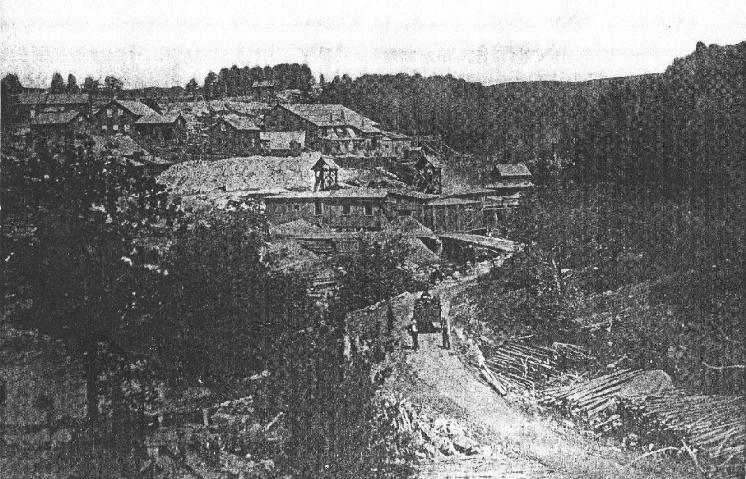
The beginning of the development of the Chateaugay Ore and Iron
Company is closely
connected with the early iron industry, which was of con-
siderable importance
to northern New York during most of the Nineteenth
Century, and especially
to Clinton and Essex counties which, 54 years ago,
produced 23 per cent
of the total iron ore output of the United States.
From 1798, when Platt erected the first forge on the Saranac River at
Plattsburg, N. Y.,
the iron business took on impetus. Year after year new ore
deposits were discovered
and ironworks started. The Saranac River, due to
its many rapids and
falls, lent itself very profitably as a source of power in
many places.
Its proximity to abundance of charcoaling timber and to numer-
ous ore beds made it
ideal for ironworks locations, of which several operated
successfully for many
years. Thus, this section of northern New York was
destined to become
a large and important part of the American Bloomery.
Closely associated with this industry were two men, Andrew Williams
and Smith M. Weed,
the founders of the Chateaugay Ore and Iron Company,
and this narrative
would not be complete without making brief mention of some
of the activities of
these two gentlemen.
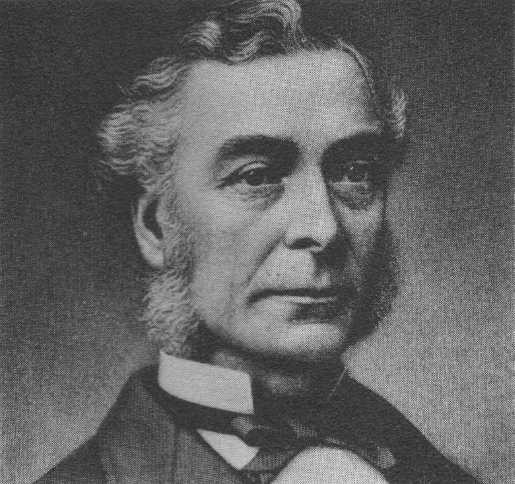
Andrew Williams
Andrew Williams, when a young man, began work at one of the
Catalan forges on the
Saranac River. Having a good common school education
to begin with, he applied
himself diligently year after year until he became one
of the best informed
and most able men in the industry, always endeavoring to
improve the quality
of his iron, continually prospecting and seeking purer and
better ore deposits.
Several years before the opening of the Chateaugay Ore Beds, it is said
that Mr. Williams had
secured samples of this ore, packed it many miles through
the forests to his
forge on the Saranac River, and made up special samples of
iron from it, which
were properly ear-marked as they went to the trade, the
customer being requested
to report back as to the quality. The splendid reports
received from various
customers in the trade on the samples of iron made from the
Chateaugay ore and
the many requests for more of it, caused Mr. Williams to
become very much interested
in the opening and development of the Chateaugay
Ore Bed, despite its
inaccessibility. It may be that he thought along the lines
of Emerson's
Mousetrap Story.* * * In any event, he associated himself with
Smith M. Weed
and, despite the many natural obstacles, undertook to open up
this ore and
make a better iron, and did so.
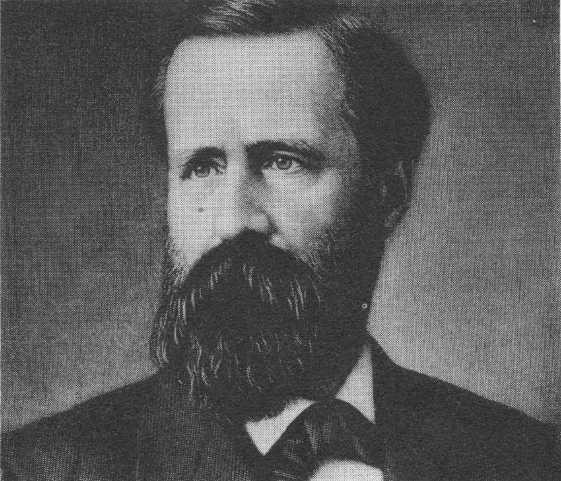
Smith M. Weed graduated from the Law School at Harvard University
in 1857, and in 1859 he married Carrie L. Standish, a daughter of Colonel
Matthew M. Standish, a lineal descendant of Colonel Miles Standish, of
Ply-
mouth. Standish, N. Y., where the Company's blast furnace is located,
was
named for Mrs. Weed's family.
Mr. Weed, in addition to being an able lawyer, was a statesman of first
rank. He was elected and re-elected many times to the State Assembly,
and
made and retained the friendship and confidence of Governors and Presidents.
Mr. Weed, more than any other one man, was responsible for interesting
the Delaware and Hudson Canal Company's officers in the building of a
railroad
between Whitehall and Plattsburg. The history of The Delaware and
Hudson
Company, "A Century of Progress," says of Mr. Weed:
Early in 1872 he journeyed to New York in the effort to interest the
Delaware and Hudson Canal Company. At a meeting with some of its
officers
and Managers, at which I. V. Baker who shared his aspirations was present,
Mr. Weed readily convinced George Talbot Olyphant, acting as president
in the
absence of Mr. Dickson, LeGrand B. Cannon and others that such a line
would
be of great advantage to the company. Thereupon Mr. Weed drew from
his
pocket articles of association of The New York & Canada Railroad Company,
already signed by several residents of Plattsburg and Clinton County.
The
remaining signatures necessary to effect its incorporation were quickly
supplied."
In later years, the two gentlemen who successfully founded and com-
mercially developed the Chateaugay Ore and Iron Company were known as
Honorable Andrew Williams and Honorable Smith M. Weed, both having won
distinction in State activities, as well as in the industrial enterprise
in which they
were interested; one a master of the industrial arts, and the other a
master in the
art of statesmanship; both of noble character.

pit1878.jpg = fullsize
In 1781, the Legislature of New York set apart, in the north central
part of the state, a tract of land containing about 665,000 acres, lying
in Clin-
ton, Franklin and Essex counties, to satisfy the claims of two regiments
of
soldiers which the State of New York had found it necessary to raise to
protect
its frontier settlements from frequent pillage by the Indians and other
enemies.
Congress was too poor to furnish troops for their protection, and so the
State
sought to raise them and pay for their services in the manner above mentioned.
This land is the so-called Old Military Tract.
* * * Many are inclined to credit Elbert Hubbard with the Mousetrap
Story. Sarah Yule, in a
book called 'Borrowings," printed many years before the Roycrofters, credits
Emerson as being
the author of the quotation.
Due to failure of the act to express clearly its meaning, and because
of its
vagueness, another act was passed in 1786, defining the area to be surveyed,
and
allowing the speedy sale of these and other unappropriated lands within
the
state. However, no part of the Old Military Tract was ever awarded
on
bounty claims. It was ultimately all sold by the State as "wild
lands." The
Town of Dannemora, in which the Chateaugay Ore Bed is located, lies in
Township No.5 of this Old Military Tract.
In September, 1794, Township No.5 became the property of William
Henderson, merchant, of New York City, who sold it in January, 1795, to
Jacob Mark. In February of the same year, Mark mortgaged it to Jacob
and
Robert Leroy, and from that time on, for about a quarter of a century,
it being
considered of little value, the property changed hands a number of times.
In 1822, it was owned by John L. Norton and Hannah Murray, who divided
it up into 300 lots which lay in what was afterwards incorporated into
the
towns of Ellenburg and Dannemora. In the apportionment of the 300
lots
between the owners, the part which lay in Dannemora fell to Hannah Murray,
who in turn conveyed it, on November 22, 1822, to Lloyd N. Rogers.
There is good reason for believing that the discovery of iron ore in the
north central portion of this tract was made many years before.
Several miles
westward of the Chateaugay Mine, and on the same strike as the Chateaugay
Ore Bed, is an old opening (81 mine), which had evidently been worked
to a
considerable extent at some remote period, a shaft having been sunk, from
which
quantities of waste which present day manufacturers would call good ore
had
been thrown out and left. Trees of considerable size had grown over
some of
this waste pile. It is reasonable to suppose that this is the so-called
Prall vein,
from which William Bailey, who erected a forge on the Chateaugay River
about five miles below the outlet of Chateaugay Lake, in 1803, obtained
his ore,
shipping it on rafts or boats through the Upper and Lower Chateaugay lakes
to his forge.
However, there does not seem to be any record of the actual discovery
of the Chateaugay Ore Bed up to the time of Mr. Rogers' purchase.
In the year
1823 the bed of ore, practically phosphorus free, now known as "Chateaugay,"
and which has been proven to be the best in the world, was supposed to
have
been discovered by an old trapper named Collins.
But the Ore Bed lay in the depths of what was then considered an almost
impenetrable wilderness, and it was many years before any attempt was
made
to work it. Even after it was known, it excited little interest
among capitalists,
for the reason that it was so far from lines of transportation, and lying
in a
region which abounded in natural obstacles, held to be practically insurmount-
able against the building of roads of any kind.
It was not until about 1868 that the first steps were taken toward
utilizing this treasure, when Messrs. Foote, Weed, Meade and Waldo made
a
contract with Edmund Law Rogers, of Baltimore, son of Lloyd N. Rogers,
and
soon after obtained possession of the property.
However, for a period of about five years there was very little done in
the way of development
of this ore body. Small groups of men were engaged
during the summer months
in digging the ore, piling it on the surface to be
loaded during the winter
months and hauled by horse-drawn sleighs on the
snow through the dense
wilderness to the Catalan forges on the Saranac River.
The interest of the above named group was soon transferred to the
Chateaugay Iron Company,
organized by Smith M. Weed and Andrew
Williams, and in the
fall of 1873, the work of developing the property began in
earnest. A plank
road was built from the Saranac River Plank Road, branch-
ing from that road
at Saranac Hollow, and running 13 miles through the
mountains to the Ore
Bed.
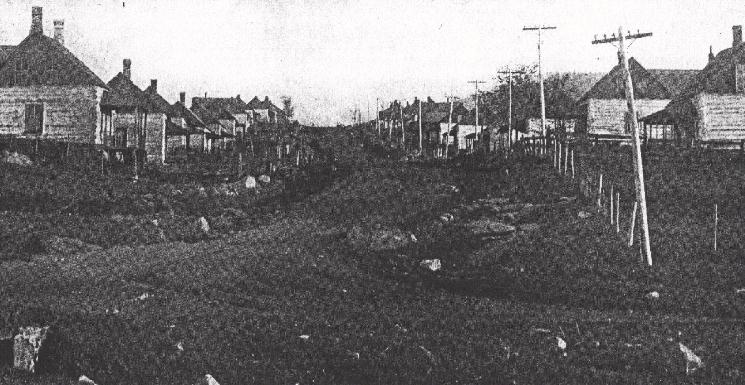
The jigging baskets consisted of a screen in the shape of a cylinder open
at the top, with a
bail to which was attached a piece of wooden timber acting
as a fulcrum or lever.
The ore was shoveled into the basket, which was then
lowered into a tank
of water and "jigged" up and down. The ore, being
heavier, sank to the
bottom of the basket, while the rock impurities formed a
layer on the top, which
was scraped off and sent to the waste pile.
The operation was continuous 24 hours daily, except Sunday, producing
approximately ten gross
tons of concentrated iron ore, containing about 55 per
cent iron. The
loss of iron in the tailings, however, was enormous. The
concentrated ore was
then loaded into wagons, which held approximately two
tons, and transported
over the plank road to Russia, N. Y., where it was made
into blooms in the
six-fire forge owned by Andrew Williams and C. F. Norton.
In the subsequent years, the property was opened up considerably. The
mines were sunk deeper,
necessitating larger hoisting equipment and also the
introduction of pumping
machinery to take care of water drainage. Up until
this time, all of the
drilling was done by hand, using jumpers and hammers,
two men drilling on
the average twelve lineal feet per shift. With the in-
troduction of compressed
air driven drilling machines, the drilling and the
tonnage per man per
day was substantially increased. A steam sawmill was
built and kept in constant
operation, turning out lumber for new buildings,
plank roads, etc.
An addition was made to the separator to take care of the
increased output of
the mines. Additional miners and mill hands were brought
in, until the total
number of employed reached about 150. This, of course,
meant that new houses
had to be built, and at this time we find about 40 houses,
a school house and
church composing the village of Lyon Mountain.
A small dam on Separator Brook, which comes brawling down from
Mount Lyon, secured
a head of 48 feet, which was suflicient to run the separator
a good portion of the
year, and a 30 horse power steam engine supplied whatever
force was lacking for
either the separator or sawmill. The Chateaugay Ore and
Iron Company now owned
over 35,000 acres of land in this immediate region,
a great portion of
which was covered with heavy timber, well adapted to lum-
bering and charcoaling
purposes. They also had a 40-year lease on 4,000
-additional acres on
which the Ore Bed was located, and with the privilege of
cutting every tree
which grew upon it. Thus, it will be seen that they had
control of nearly 40,000
acres of land, with a large supply of iron ore under it
and plenty of charcoaling
timber on its surface.
With the increasing of men and machinery the output of concentrated
ore reached approximately
50 gross tons per day, containing about 55 per cent
iron. This was
loaded into wagons and hauled over a splendid plank road to
the dock on Upper Chateaugay
Lake. Here it was transferred into barges,
which were towed to
the Company's forge fires at Belmont, at the outlet of
Lower Chateaugay Lake,
by the Company's steamer, "Maggie," named after
Miss Maggie Weed (daughter
of Hon. Smith M. Weed).
The "Maggie" was 28 1/2 feet long over all, with an 11 foot beam,
drawing four feet of
water. It was driven at the rate of ten miles per hour, by
a 25 horse power steam
engine. The barge, the "Iron Age," was 80 feet long
and 17 feet wide, and
carried approximately 150 tons of ore. After the ore
was transported to
its destination, it was transferred by hand to a small car
which was drawn by
a cable to the stock piles at the forges.
At the outlet of Chateaugay Lake, at Belmont, ground was broken for
the erection of a dam
and ironworks, in the year 1874, and operations began
in January of the following
year. The entire operations were driven by
water power under a
head of 18 feet. The "mill pond" was 12 miles long,
both Upper and Lower
Chateaugay Lakes having been raised by the dam about
4 1/2 feet. All
the wood, coal and ore were moved on the Lake in barges and
rafts by the "Maggie."
Each Fall before the close of navigation, enough ore was
stored at Belmont to
run the forges through the Winter. There were ten first-
class fires, which
were increased in later years to 20, the largest Catalan forge in
operation in the country,
if not in the world, at that time.
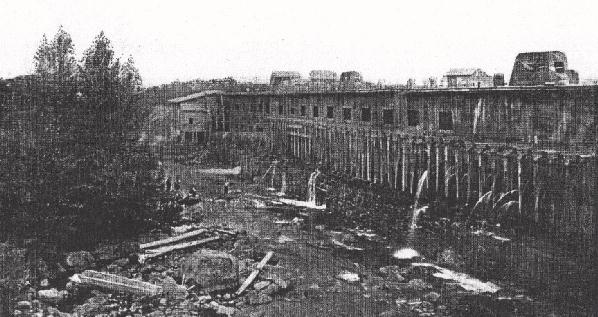
Go to Mine History Page 2 ........
![]()

